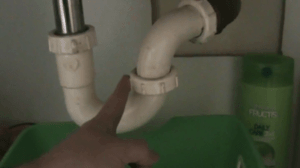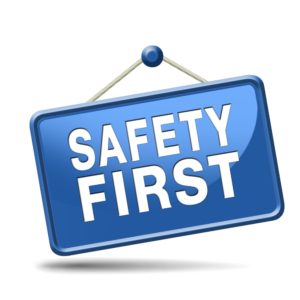This post may contain affiliate links. Please read the disclosure for more info.
During the various remodels that I have done over time I had to do my fair share of plumbing. I can recall a point where the kids had broken the drain plug when they were playing with toys in the sink. I had a honey-do list and going to buy a new drain plug and installing it was way at the bottom. During that time the drain plug in the sink was like a black hole where we constantly lost things. I had to research and learn how to take apart the p-trap and retrieve the item. It took me several weeks to install a new drain plug so I got very good at taking a p-trap apart and replacing it.

- What do you do when your ring goes down the drain? First and most importantly don’t run the water and in fact shutting off the ball valve so there is no chance of water running is a good idea.
- Shutting off the water needs to be an immediate reaction even if you see the object or feel it is lodged in place. Additionally, by shutting off the water you prevent any possibility of a flood once you remove the p-trap, u-bend or j-bend. For simplicity sake, I will only refer to a p-trap, but both serve the same purpose.
- The p-trap is a fitting designed to hold water at the base of all plumbing fixtures, likes sinks, toilets, tubs or showers, to prevent sewer gases from escaping into the room.
- A p-trap is also used to create a bottleneck to create a clog in the trap and prevent clogs further down in the sewer lines.
- If the object is in the tailpiece (a straight piece of pipe directly under the sink and not fallen into the p-trap you can try to retrieve it by removing the drain plug, use a magnet for metal objects or a coat hanger to try and grasp it.
- If it’s not visible good chances are it fell to the p-trap and you can follow the following steps to retrieve it.
- Clean out the area directly underneath and place a bowl, bucket or container to catch the residual water that is always in the p-trap by design.
- If your p-trap has a clean out trap, then you can remove that to let the water drain and the object fall into the bucket you have below.
- If your p-trap does not have a clean out trap, then you can loosen the two slip joints connecting the p-trap to the downpipe and straight pipe.
- Once you loosen the slip joints, remove the p-trap and dump out any excess water. If it is very clogged, you can use a coat hanger or toothbrush to help remove debris in the trap.
- At this point, you can retrieve the item you are looking for.
- After you retrieve your item you can replace the p-trap by aligning it back up to the slip joints and hand tightening them.
- Turn on the water and test for leaks.
Retrieving an item from the drain does have some variables to watch out for, as well as issues that can arise. Continue reading below or watch the video to learn more and ensure success on your project while avoiding common mistakes.
Jump To:
Tips to remember when retrieving an item dropped down the drain.
- Be sure not to overtighten the slip joints.
- Keep in mind while it’s not possible to retrieve every item dropped down the bathroom sink, most can be recovered following the simple steps above.
- Keep in mind the sewer line is gravity fed so ensure any plumbing pipe you are installing will slope a ¼” for every 1 foot of pipe. Installing a p-trap only has a few inches of trap arm leading to the drain pipe, but its still a good idea to practice proper plumbing!
- Wear eye protection.
- Wear gloves if you don’t want to touch the grimy water.
What tools do I need to remove a p-trap?

- For slip joints or a trap, you can usually use your hands or a set of pliers to gently loosen and tighten them.
- For a p-trap that does not have slip joints or a trap, you will need a reciprocating saw, a coupling either flexible or plastic.
- For plastic couplings and pipe, you will need a PVC cleaner and cement.
- For a flexible coupling, you can use a screwdriver or wrench to tighten it on both sides.
- Level and measuring tape to ensure your plumbing has the correct slope.
What do I do if my p-trap doesn’t have slip joints?
- First and still most important don’t run the water and in fact shutting of the ball valve so there is no chance of water running is a good idea. Shutting off the water needs to be an immediate reaction regardless of the p-trap design.
- As stated earlier if the object is in the down pipe and not fallen into the p-trap you can try to retrieve it by removing the drain plug, use a magnet for metal objects or a coat hanger to try and grasp it.
- If it’s not visible good chances are it fell to the p-trap and you can follow the following steps to retrieve it.
- Clean out the area directly underneath and place a bowl, bucket or container to catch the residual water that is always in the p-trap by design.
- Since your p-trap does not have slip joints or clean out plug you will need to cut the pipe to remove the object. If you are not comfortable with the process of cutting plumbing and attaching couplings together, I would suggest you call a plumber.
- If you want to continue forward, you will need to use a hacksaw, PVC pipe cutter or reciprocating saw to cut the downpipe and the trap arm.
- Once you cut the p-trap away from the sewer lines you can remove the excess water and the object from the drain.
- Now that you have the object you will need to repair the cut pieces by shortening their lengths and adding a coupling to allow for the re-connection of the p-trap.
- Turn on the water and test for leaks.
What do I do if I smell sewer gas coming from my drain?

The most common cause of sewer gas smell coming from a drain is due to the drain being dry.
A drain has a p-trap design that allows for water to sit in the trap to block sewer gas from coming back into the pipe.
It is possible that a p-trap can dry out when you are not running water for long periods of time. For example, if you have a vacation home that you do not visit for long periods of time it is possible that sewer gas will enter the home once the water in the p-trap evaporates.
Running water for a few seconds will allow the p-trap to fill back up and block the sewer gas.
If that doesn’t work another cause of sewer gas smell can be due to having an s-trap design installed.
S-traps are not allowed by code anymore in the US for new construction and remodel, but if your home has one this can be the culprit.
An S-trap can cause the small diameter pipe to be filled with water and due to the s-trap design, the distance from the downward turn being short the speed of the flow of water causes it to pull more water out of the trap yielding the same issue as above.
If that doesn’t work another cause and most costly repair thus far to remove a sewer gas smell coming from a drain is due to an undersized drainpipe. An undersized drain pipe will cause drain water to suck the water of the trap, which allows sewer gas to enter the room. To remediate this, you will need to ensure you have the properly sized drainpipes.
Finally sewer gas can come from a clogged or cracked vent pipe where gases are meant to exhaust to the outside.
Safety Information to consider when retrieving an item from the drain.

Depending on the age of your home and plumbing use caution that the pies are not fragile or corroded. Working on pipes in this condition can cause pipes to break resulting in more costly repairs than you were expecting.
Always call a plumber if you are not comfortable with the situation you are facing.
Always shut off the water prior to beginning any plumbing work.
Wear eye protection.

